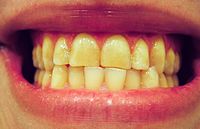
Photo from wikipedia
Objective To assess the prevalence of temporomandibular disorder (TMD) and its association with text anxiety among undergraduate medical, dental, and pharmacy students in Dammam, Saudi Arabia. Material and Methods. This… Click to show full abstract
Objective To assess the prevalence of temporomandibular disorder (TMD) and its association with text anxiety among undergraduate medical, dental, and pharmacy students in Dammam, Saudi Arabia. Material and Methods. This cross-sectional study included health professions students who responded to Fonseca's questionnaire and Test Anxiety Inventory by Spielberger to evaluate TMD and test anxiety, respectively. TMD score was compared in different categories of students, and bivariate and multiple logistic regression analyses evaluated the influence of test anxiety on TMD. Results The study included 884 participants (44.8% males and 55.2% females) with a mean age of 21.46 ± 1.36 years. Regarding items of Fonseca's questionnaire, most students reported being tense/nervous (65.7%) and had headaches (57.5%). About 45.8% of the participants reported no TMD, and remaining had mild (40.4%), moderate (11.3%), and severe (2.5%) TMD. The mean TMD score was significantly higher in students with high test anxiety (25.6 ± 18.32) than those with low test anxiety (20.25 ± 16.97) (P < 0.001). Mean test anxiety scores significantly differed among TMD categories (P < 0.001) with the lowest score in the no TMD group and the highest in the moderate TMD group. Female gender (adjusted odds ratio 1.4, P 0.039) and high test anxiety (adjusted odds ratio 1.92, P < 0.001) were significantly associated with increased odds of having TMD. Conclusions The study revealed a high prevalence of TMD among students. There was a significant association between test anxiety and TMD. The data obtained may guide preventive policies and program on test anxiety and TMD.
Journal Title: International Journal of Dentistry
Year Published: 2020
Link to full text (if available)
Share on Social Media: Sign Up to like & get
recommendations!